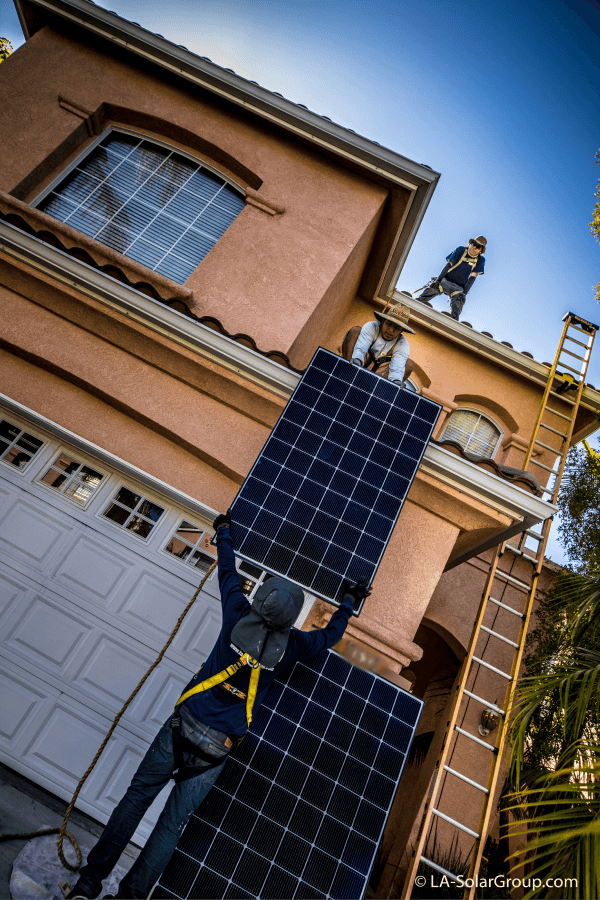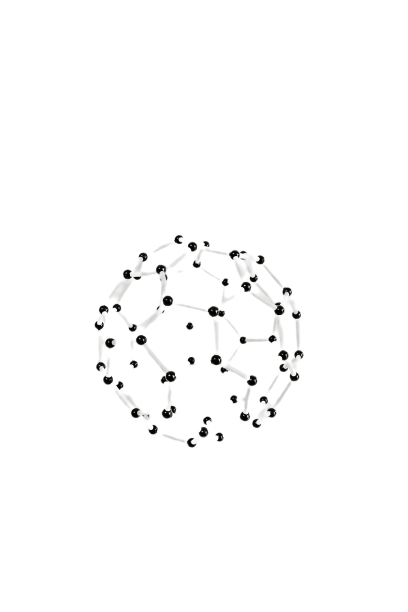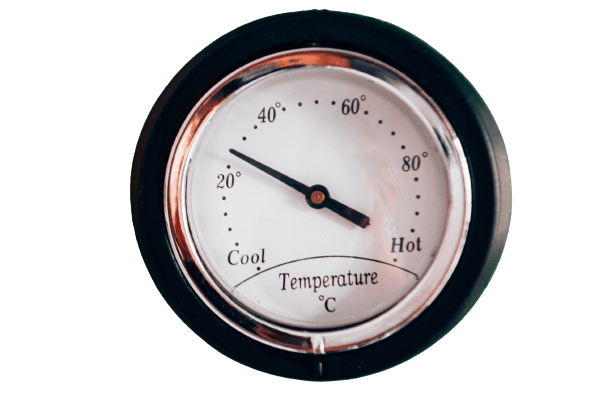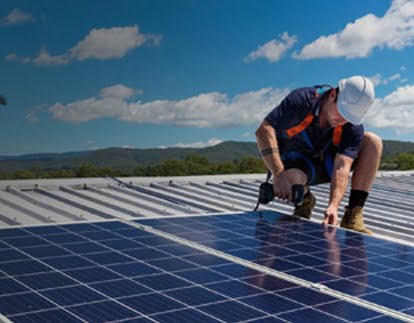What is Solar Energy?
What is Solar Energy?
The sun’s radiation which we refer to as solar energy (a.k.a. solar power), is the most abundant energy source in our solar system and is the largest source of energy source here on Earth. According to energy.gov, 173,000 terawatts of solar energy strikes the Earth continuously. That’s more than 10,000 times the world’s total energy use today. Another form of solar energy is called solar thermal energy. Solar thermal systems can be used to harness the power of solar energy by creating thermal mass and producing heat for your water heating system in your home or business. If designed and installed properly, your utility bills would be reduced as a result of this. As a renewable resource, solar power is an important, essential and integral part of our clean energy future. The future of clean energy depends on solar projects like ours and people like you. We assist by providing you simple turnkey solution to your home or business needs.
The sun is more than just a provider of light during the daytime. Each photon of sunlight that reaches Earth contains energy which gives rise to life and fuels the planet with warmth. The most important and primary source of all heat at the surface level of Earth.
Where does all this energy originate from? Our sun, just like any star in other solar system is a gigantic nuclear reactor. Massive amounts of energy are produced by nuclear fusion. Within the core of the sun, its effects can be felt millions of miles away by which nuclear fusion reactions are occurring. The energy is released and radiates to us here on Earth. The energy emitted far into space in the form of light and heat has no boundaries. When it travels millions of miles and hits any surface out in space, it provides warmth and solar energy.
Photovoltaics (PV) and solar thermal mass collectors can be used to be able to harness the power of sunlight. We then can make use of the power of sunlight by harnessing the power of sunshine to convert or transform the solar energy into usable energy. Even though existing solar systems account for only a small percentage of global energy consumption, the rising cost and economies of scale however means more people will and can benefit from using the technology. Solar systems are considered a renewable source. Solar energy is a sustainable and clean resource that is expected to play an important role in the future development of clean global energy.


solar energy VS Solar Thermal
The sun’s energy can be harnessed in several different ways. The two most common ways are Photovoltaics (PV or Solar Panels) and Solar Thermal (Thermal Heaters). PV are the most popular since we use electrical energy for almost all of our needs and are increasingly becoming more in demand. The scale of the solar project depends on the system design and the budget available which tends to vary on a case by case basis for both residential and commercial. There are some large scale projects that use mirrors to concentrate solar thermal energy into one point for heating liquid at boiling point to then turn a generator with air pressure.
Photovoltaic cells are only becoming more affordable as time goes by and efficiency ratings are increasing year over year. If the trend continues, solar energy production will continue to play an important role in reducing utility costs throughout the world. The financial benefits of solar panels are increasing every year. Going solar will add to the environmental benefits of using a renewable energy source.
solar energy VS Solar Thermal
The sun’s energy can be harnessed in several different ways. The two most common ways are Photovoltaics (PV or Solar Panels) and Solar Thermal (Thermal Heaters). PV are the most popular since we use electrical energy for almost all of our needs and are increasingly becoming more in demand. The scale of the solar project depends on the system design and the budget available which tends to vary on a case by case basis for both residential and commercial. There are some large scale projects that use mirrors to concentrate solar thermal energy into one point for heating liquid at boiling point to then turn a generator with air pressure.
Photovoltaic cells are only becoming more affordable as time goes by and efficiency ratings are increasing year over year. If the trend continues, solar energy production will continue to play an important role in reducing utility costs throughout the world. The financial benefits of solar panels are increasing every year. Going solar will add to the environmental benefits of using a renewable energy source.

Photovoltaic solar energy
Photovoltaic (PV) also known as solar photovoltaic is a common way property owners can take advantage of the sun’s energy. A solar PV system converts sunlight into electricity. The solar panels can then be stored in a battery or sent to the grid to receive credit on your electric bill. Photovoltaic effect is a method by which solar panels convert sunlight into electricity. The photovoltaic effect is when sunlight strikes a semiconductor material, such as silicon. This sets electrons free and generates an electric current that can then be captured using wiring. This current is called direct current (DC), and it must be converted into alternating current (AC), electricity by the use of a solar converter. This is required because most household appliances use AC in the 21st century. Lastly, the electric grid uses AC electricity.
Photovoltaics can capture solar energy at many scales. Installing solar panels is an efficient way to reduce your dependence on fossil fuels and|of fossil fuels, and also save money on your electricity bill. Photovoltaic solar energy generation can also be beneficial for large companies and electric utilities. Large solar arrays can generate power to the electrical grid.


Solar thermal
Another way to make use of solar energy is to directly capture the sun’s heat and then use it in many different ways. Although solar thermal energy is more versatile than photovoltaic, it’s not as practical to use on a small scale for electricity generation as photovoltaics.
There are three types of solar thermal energy that can be used: low-temperature is used to heat and cool; mid-temperature is used to heat water; high temperature is used for electricity generation.
Low-temperature solar thermal systems use heating and cooling to regulate the climate. Passive solar building design is an example of this type. Passive solar energy is when the sun’s rays are allowed to enter a living space in order to heat it. They are then blocked to cool it.
Solar hot water heating systems are a mid-temperature option for solar thermal energy systems. A solar hot water system captures heat from the sun using collectors mounted on your roof. The heat is transferred to your home’s water piping, so you don’t need to rely on traditional heating methods like oil- or gas-powered water heaters.
For generating larger amounts of electricity, high-temperature solar thermal energy systems are used. A solar thermal electricity plant uses mirrors to focus the sun’s rays onto tubes that contain a liquid that can retain heat energy well. The heated fluid can be used to heat water and steam, which can then turn a turbine|the turbine into electricity. This technology is sometimes referred to as concentrating solar power.
Solar thermal
Another way to make use of solar energy is to directly capture the sun’s heat and then use it in many different ways. Although solar thermal energy is more versatile than photovoltaic, it’s not as practical to use on a small scale for electricity generation as photovoltaics.
There are three types of solar thermal energy that can be used: low-temperature is used to heat and cool; mid-temperature is used to heat water; high temperature is used for electricity generation.
Low-temperature solar thermal systems use heating and cooling to regulate the climate. Passive solar building design is an example of this type. Passive solar energy is when the sun’s rays are allowed to enter a living space in order to heat it. They are then blocked to cool it.
Solar hot water heating systems are a mid-temperature option for solar thermal energy systems. A solar hot water system captures heat from the sun using collectors mounted on your roof. The heat is transferred to your home’s water piping, so you don’t need to rely on traditional heating methods like oil- or gas-powered water heaters.
For generating larger amounts of electricity, high-temperature solar thermal energy systems are used. A solar thermal electricity plant uses mirrors to focus the sun’s rays onto tubes that contain a liquid that can retain heat energy well. The heated fluid can be used to heat water and steam, which can then turn a turbine|the turbine into electricity. This technology is sometimes referred to as concentrating solar power.


Why is it good to use Solar Energy?
1. Solar Energy is Good for the environment
The sun can be an excellent alternative source of energy. Solar energy doesn’t generate carbon dioxide like fossil fuels. This makes solar energy greener than other energy sources.
Our planet is polluted due to fossil fuels, such as oil, coal as well as natural gas. They release huge quantities of greenhouse gasses into our air when they burn. These include:
- Carbon Dioxide
- Methane
- Nitrous Oxide
The greenhouse effect, which is a major contributor to climate change can be attributed to greenhouse gases. They affect breathing air and cause the pollution of the atmosphere. These gases can be eliminated by making use of the sun instead fossil fuels. It is therefore healthier for the environment and can reduce the impact of climate change.
2. The Sun is renewable
The sun will burn for until there is enough earth to support it. It can therefore be considered a source of renewable energy. It will never be depleted, and you can make use of it every day.
Wind, solar and geothermal power are all vital in decreasing our dependence on non-renewable resources. There will be a time when we will be out of oil, coal, and gas. This is good because we will always be able to rely on solar power.
3. Solar Power Can Increase Energy Security
Energy security refers to a country’s capability and willingness in managing its power supply. Most countries must purchase at least a portion of their energy needs. Low energy security is the situation where a country depends heavily on foreign energy sources.
Because it is crucial to the nation’s economic growth Security in energy is crucial to the country’s economy. A country with good secure energy is more prone to external forces that can increase the cost of energy commodities. Wars and conflicts are the most common causes of rising energy costs, which can cause economic harm.
A country can increase its energy security by making use of more solar energy. The deployment of large-scale solar cells has been successful in countries like India as well as China. A large number of European countries have seen an rise in the production of solar energy.
4. It is believed that the Solar Industry creates jobs
Globally the solar photovoltaics industry generated more than 3.6 million jobs in the year 2018. These data are taken from a 2019 report of the International Renewable Energy Agency (IRENA). The report focuses on renewable energy jobs.
China accounts for around 31 percent in these positions. Japan follows with 7%, Germany at 5.5% along with the United States at 4.4%. From a perspective of economics, it is important to note that solar power is able to support many jobs around the globe.
5. There are many applications for solar energy.
We’ve talked about solar panels to generate power. However, solar energy could be utilized for different uses other that are not related to electricity generation.
The sun’s rays can be used to warm water with the solar thermal technique. Solar energy doesn’t have to be used to generate electricity. Many homeowners have put in solar thermal collectors, solar panels and even solar collectors to increase the solar energy benefits.
6. It can reduce your energy bills
Solar energy is a great way to reduce or even eliminate, your energy costs. Many homeowners opt to install solar power systems because of this. It doesn’t matter if you utilize the sun for heating water or to generate electricity and reduce your utility bills.
This is one of the main advantages of solar energy, and has transformed the lives of millions across the world.
7. Active Solar Technologies offer a return on investment
It is true that the solar power will lower your monthly utility bill is related to its ability to may also generate a return on investment. In the event that the price you pay for the the technology is more than what you’ll pay in the long run the savings won’t be worth it. your utility bills.
Both solar electricity and solar hot water system can give you a return on investment (ROI) in the duration over the course of. While this requires careful research and a favorable climate ROI is possible across the world. Before you decide to invest in such systems, be sure to find a reliable installer.
8. There are many other advantages of sun's natural ingredients.
The natural benefits that the sun offers to our planet are the last on our list. This is an important element that is often overlooked, but it is something we need to be aware of.
The sun in many different ways helps life on Earth. It is vital to the growth of crops and also for sustaining the habitats and requirements of living creatures.
Another term for Solar Energy is Renewable energy
Renewable energy is often mentioned as a viable alternative to reduce the most severe effects of increasing temperatures. This is because renewable energy sources such as solar and wind don’t emit carbon dioxide and other gases that could contribute to global warming.
There are numerous benefits of green energy that go beyond the fact that it is “green”. The industry is expanding and is creating new jobs. It also makes electricity grids more robust and improves access to energy in developing countries. And it helps lower the cost of energy. These factors have all played a role in the recent revival of renewable energy, with solar and wind setting new records for electricity production.
In the last 150 years, humankind has heavily relied on oil, coal, and other fossil fuels to power everything including light bulb to automobiles and factories to vehicles to automobiles. The greenhouse gases generated by fossil fuels burning them have reached historic highs.
The average temperature of the surface is rising due to greenhouse gases trapping heat that could otherwise go to space. Global warming is a sign that climate changes are taking place. Scientists use the term”climate change” to describe the complex changes affecting the climate and weather systems of our planet. Climate change can be described as rising temperatures, extreme weather events, shifting wildlife habitats and populations, rising seas and a myriad of other effects.
Like any other source of energy are not without their own set of trade-offs. One of them are the terms used to define renewable electricity. Renewable energy, strictly speaking is exactly what you think it is. It’s always available or, as it is described by the U.S. Energy Information Administration states, “virtually unlimited.” However, “renewable,” does not necessarily mean sustainable . There are the main opponents to hydropower dams or corn-based ethanol. It does not include other sources that have emissions that are low or zero, and are also backed by advocates, such as energy efficiency and nuclear power.
3 Examples of Renewable Energy sources
Hydropower: People have used the power of rivers for many centuries in order to tap into their energy and construct dams to regulate the flow of water. The biggest source of national renewable energy labs is hydropower. It is the largest producer of hydropower and has China, Brazil and Canada being the top producers. Although hydropower could theoretically be a source of clean energy that is replenished by rain or snow however, there are a few drawbacks.
Large dams can cause disruption to river ecosystems and communities. The result could be the displacement of residents and wildlife. Silt buildup can cause hydropower generation to be less efficient , and also damage equipment. The drought can also cause problems. According to a 2018 study carbon dioxide emissions in the Western U.S. were 100 megatons higher than usual over a 15-year period. This was due to utilities switching on gas and coal to replace lost hydropower because of drought. Hydropower, even when it is at its maximum capacity, has emissions issues as the decaying organic material in reservoirs emits methane.
Not only are dams the best way to harness water’s power, but so are tide and wave energy. Although marine energy projects generate less than one percent of renewable energy, they still have the potential to produce 500 megawatts. This is a trend that has been boosted by programs like that of the Saltire Prize in Scotland.
Wind: The energy of wind has been utilized to generate energy for more than 7,000 years. Wind turbines, which generate electricity are now popping up throughout the world, with China, the U.S. The United States and Europe are the largest producers of wind power. Between 2001 and 2017, the world’s cumulative wind power grew by 22-fold. It was 23,900 mw, but it could generate 539,000 megawatts.
Although some might be dissatisfied with how wind turbines look in the sky or their sounds, wind power is now too valuable to ignore, because of its falling cost. Although most wind power comes from onshore turbines most of it comes from offshore wind farms. The most prominent being in the U.K. and Germany. In 2016 the first U.S. offshore wind farms was launched in Rhode Island. Others offshore wind farms are also getting more attention. Wind turbines pose a threat to bats and birds. They kill thousands of bats and birds annually, but they are not as numerous as collisions with glass or other dangers such as habitat destruction and invasive species. Engineers are seeking ways to make them more secure for wildlife flying through them.
Solar: Solar cells have revolutionized the energy market all over the world, from rooftops on homes to large-scale farms. The installed photovoltaic panel capacity for energy has grown by 4,300 percent in the 10 years between 2007 and 2017.
Apart from solar panels , which convert direct sunlight to electricity, concentrating solar power (CSP) plants also use mirrors to concentrate solar power plants and extract thermal energy. The U.S., Japan and China are the leaders in the field of solar transformation. However, solar requires a lot to complete. In 2017 in the U.S. generated around two percent of the electricity. Worldwide, solar thermal energy is being used for solar heating and cooling as well as hot water.
Solar energy can be used to power your home
The installation of a photovoltaic solar residential system is the ideal method to conserve money on solar energy. The LA Solar Group|company’s|The LA Solar Group} Solar Marketplace is a great starting point to look for the right system for your needs at a reasonable cost. Sign up for free estimates from pre-screened, certified solar installers in your area. It’s easy to evaluate quotes, and understand crucial metrics such as the energy requirement and cost per watt.

